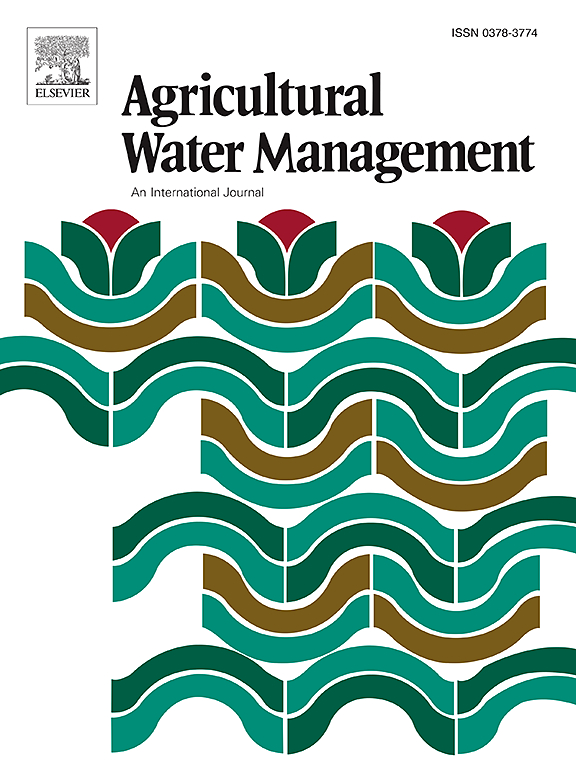Optimizing the nitrogen application rate and planting density to improve dry matter yield, water productivity and N-use efficiency of forage maize in a rainfed region
IF 5.9
1区 农林科学
Q1 AGRONOMY
引用次数: 0
Abstract
Appropriate nitrogen (N) fertilization and planting density management are critical for efficient production of grain maize (Zea mays L.) and for environmental protection. However, the optimal N fertilization and planting density is still not established for forage maize that is cultivated to promote its vegetative growth and utilized for the above-ground vegetative mass. A two-year field experiment was conducted in the rainfed semiarid region of the Chinese Loess Plateau during the 2021 and 2022 growing seasons. The effects of N application rates and planting densities on the dry matter yields and the water- and N-use efficiencies of forage maize were studied. The experiment includes four N application rates (0, 90, 180, and 270 kg ha−1) and three plant densities (70000, 90000, and 110000 plants ha−1), covering the conventional practices of local farmers. The treatments were organized in a randomized complete block design with four replications. Averaged over the three plant densities, N application rate of 180 kg ha−1 resulted in the maximum average aboveground dry matter yield (18.6 t ha−1), crop N accumulation (228.5 kg ha−1), dry matter water productivity (51.9 kg ha−1 mm−1), and dry matter precipitation productivity (62.9 kg ha−1 mm−1) over the two years. Moreover, increasing N application rates significantly increased the soil nitrate-N accumulation (0–200 cm) but reduced the partial factor productivity of applied N fertilizer. Across the three plant densities, the two-year average soil nitrate-N accumulation was 12.6, 32.1, and 75.7 % higher with 90, 180, and 270 kg N ha−1 compared to no N treatment, respectively. The highest soil nitrate accumulation under 270 kg ha−1 N application rate in 2021 (229.5 kg ha−1) and in 2022 (329.7 kg ha−1) may cause severe nitrate leaching loss and potential soil water contamination, driven by intensive rainfalls. Averaged over the four N rates, planting density of 110000 plants ha−1 increased the crop N accumulation and PFP by 21.2 % and 15.8 % in 2021, compared to 70000 plants ha−1, respectively. The interaction of N application and planting density significantly affected the aboveground dry matter yield, crop water consumption, dry matter precipitation productivity, and crop N accumulation in 2021, but the effect was non-significant in 2022. Based on these findings, application of 180 kg N ha−1 and planting density of 110000 plants ha−1 are suggested as an efficient management strategy for improving productivity of forage maize and soil water and N resources utilization in the arid region of the Loess Plateau and similar areas.
优化施氮量和种植密度,提高雨养地区饲用玉米的干物质产量、水分生产率和氮利用效率
适当的氮肥施用和种植密度管理对于谷物玉米(Zea mays L.)的高效生产和环境保护至关重要。然而,对于为促进无性生长而栽培并利用地上植株的饲用玉米来说,最佳氮肥施用和种植密度仍未确定。2021 年和 2022 年生长季节,在中国黄土高原的雨养半干旱地区进行了为期两年的田间试验。研究了施氮量和种植密度对饲用玉米干物质产量以及水分和氮利用率的影响。试验包括四种氮肥施用量(0、90、180 和 270 千克/公顷-1)和三种种植密度(70000、90000 和 110000 株/公顷-1),涵盖了当地农民的常规做法。处理采用随机完全区组设计,四次重复。从三种种植密度的平均值来看,180 千克/公顷的氮施用量使两年的平均地上部干物质产量(18.6 吨/公顷)、作物氮积累(228.5 千克/公顷)、干物质水分生产率(51.9 千克/公顷-1 毫米-1)和干物质降水生产率(62.9 千克/公顷-1 毫米-1)最大。此外,增加氮肥施用量能显著增加土壤硝态氮积累(0-200 厘米),但却降低了施用氮肥的部分全要素生产率。在三种植株密度下,与不施氮肥相比,90、180 和 270 千克/公顷氮肥的两年平均土壤硝态氮累积量分别高出 12.6%、32.1% 和 75.7%。在 2021 年(229.5 千克/公顷-1)和 2022 年(329.7 千克/公顷-1),270 千克/公顷-1 施氮量下的土壤硝酸盐累积量最高,这可能会导致严重的硝酸盐淋失,并在密集降雨的影响下造成潜在的土壤水污染。四种氮肥施用量的平均值为:2021 年,11 万株/公顷的种植密度比 7 万株/公顷的种植密度分别增加了 21.2% 和 15.8%的作物氮积累和全磷酸盐。施氮量与种植密度的交互作用在 2021 年显著影响了地上部干物质产量、作物耗水量、干物质降水生产力和作物氮积累,但在 2022 年影响不显著。根据上述研究结果,建议在黄土高原干旱地区及类似地区采用每公顷施用 180 千克氮和每公顷种植 11 万株的种植密度作为提高饲用玉米产量和土壤水分及氮资源利用率的有效管理策略。
本文章由计算机程序翻译,如有差异,请以英文原文为准。
求助全文
约1分钟内获得全文
求助全文
来源期刊

Agricultural Water Management
农林科学-农艺学
CiteScore
12.10
自引率
14.90%
发文量
648
审稿时长
4.9 months
期刊介绍:
Agricultural Water Management publishes papers of international significance relating to the science, economics, and policy of agricultural water management. In all cases, manuscripts must address implications and provide insight regarding agricultural water management.
 求助内容:
求助内容: 应助结果提醒方式:
应助结果提醒方式:


